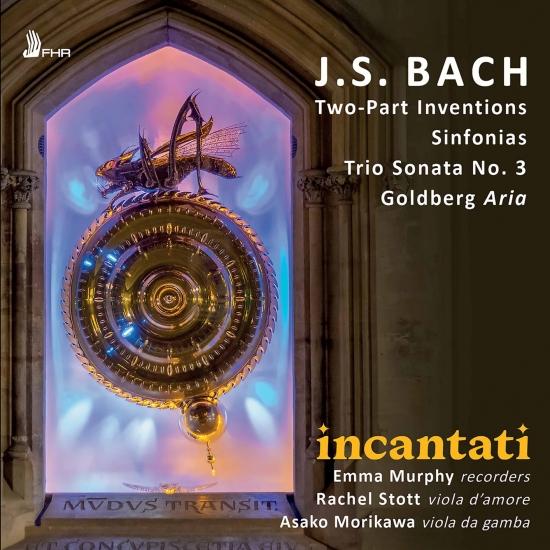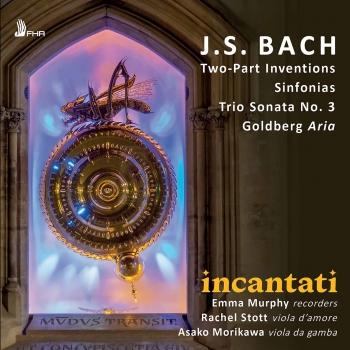
J.S. Bach: Keyboard Works (Arr. for Baroque Ensemble) Incantati
Album info
Album-Release:
2022
HRA-Release:
11.03.2022
Label: First Hand Records
Genre: Classical
Subgenre: Chamber Music
Artist: Incantati
Composer: Johann Sebastian Bach (1685–1750)
Album including Album cover Booklet (PDF)
- Johann Sebastian Bach (1685 - 1750): Sinfonia No. 1 in C Major, BWV 787 (Arr. for Viola d'amore, Viola da gamba & Alto Recorder):
- 1Bach: Sinfonia No. 1 in C Major, BWV 787 (Arr. for Viola d'amore, Viola da gamba & Alto Recorder)01:17
- Invention No. 7 in E Minor, BWV 778 (Arr. for Viola da gamba & Voice Flute):
- 2Bach: Invention No. 7 in E Minor, BWV 778 (Arr. for Viola da gamba & Voice Flute)01:42
- Invention No. 11 in G Minor, BWV 782 (Arr. for Viola da gamba & Tenor Recorder):
- 3Bach: Invention No. 11 in G Minor, BWV 782 (Arr. for Viola da gamba & Tenor Recorder)01:54
- Sinfonia No. 4 in D Minor, BWV 790 (Arr. for Viola d'amore, Viola da gamba & Alto Recorder):
- 4Bach: Sinfonia No. 4 in D Minor, BWV 790 (Arr. for Viola d'amore, Viola da gamba & Alto Recorder)02:16
- Invention No. 4 in in D Minor, BWV 775 (Arr. for Viola d'amore & Viola da gamba):
- 5Bach: Invention No. 4 in in D Minor, BWV 775 (Arr. for Viola d'amore & Viola da gamba)01:20
- Invention No. 13 in A Minor, BWV 784 (Arr. for Viola d'amore & Viola da gamba):
- 6Bach: Invention No. 13 in A Minor, BWV 784 (Arr. for Viola d'amore & Viola da gamba)02:05
- Fuga super "Allein Gott in der Höh sei Ehr", BWV 716 (Arr. for Viola d'amore, Viola da gamba & Voice Flute):
- 7Bach: Fuga super "Allein Gott in der Höh sei Ehr", BWV 716 (Arr. for Viola d'amore, Viola da gamba & Voice Flute)02:45
- Wer nur den lieben Gott lässt walten, BWV 691 (Arr. for Viola d'amore, Viola da gamba & Tenor Recorder):
- 8Bach: Wer nur den lieben Gott lässt walten, BWV 691 (Arr. for Viola d'amore, Viola da gamba & Tenor Recorder)02:56
- Sinfonia No. 8 in F Major, BWV 794 (Arr. for Viola d'amore, Viola da gamba & Alto Recorder):
- 9Bach: Sinfonia No. 8 in F Major, BWV 794 (Arr. for Viola d'amore, Viola da gamba & Alto Recorder)01:29
- Invention No. 1 in C Major, BWV 772 (Arr. for Viola d'amore & Soprano Recorder):
- 10Bach: Invention No. 1 in C Major, BWV 772 (Arr. for Viola d'amore & Soprano Recorder)01:24
- Invention No. 2 in C Minor, BWV 773 (Arr. for Viola d'amore & Soprano Recorder):
- 11Bach: Invention No. 2 in C Minor, BWV 773 (Arr. for Viola d'amore & Soprano Recorder)01:58
- Sinfonia No. 9 in F Minor, BWV 795 (Arr. for Viola d'amore, Viola da gamba & Tenor Recorder):
- 12Bach: Sinfonia No. 9 in F Minor, BWV 795 (Arr. for Viola d'amore, Viola da gamba & Tenor Recorder)03:44
- Invention No. 10 in G Major, BWV 781 (Arr. for Viola d'amore & Viola da gamba):
- 13Bach: Invention No. 10 in G Major, BWV 781 (Arr. for Viola d'amore & Viola da gamba)01:05
- Organ Sonata No. 6 in G Major, BWV 530:
- 14Bach: Organ Sonata No. 6 in G Major, BWV 530: II. Lento (Arr. for Viola d'amore, Viola da gamba & Voice Flute)05:24
- Trio super "Herr Jesu Christ, dich zu uns wend", BWV 655 (Arr. for Viola d'amore, Viola da gamba & Alto Recorder):
- 15Bach: Trio super "Herr Jesu Christ, dich zu uns wend", BWV 655 (Arr. for Viola d'amore, Viola da gamba & Alto Recorder)04:07
- Sinfonia No. 11 in G Minor, BWV 797 (Arr. for Viola d'amore, Viola da gamba & Voice Flute):
- 16Bach: Sinfonia No. 11 in G Minor, BWV 797 (Arr. for Viola d'amore, Viola da gamba & Voice Flute)02:08
- Invention No. 8 in F Major, BWV 779 (Arr. for Viola da gamba & Soprano Recorder):
- 17Bach: Invention No. 8 in F Major, BWV 779 (Arr. for Viola da gamba & Soprano Recorder)01:15
- Invention No. 15 in B Minor, BWV 786 (Arr. for Viola da gamba & Alto Recorder):
- 18Bach: Invention No. 15 in B Minor, BWV 786 (Arr. for Viola da gamba & Alto Recorder)01:34
- Sinfonia No. 13 in A Minor, BWV 799 (Arr. for Viola d'amore, Viola da gamba & Voice Flute):
- 19Bach: Sinfonia No. 13 in A Minor, BWV 799 (Arr. for Viola d'amore, Viola da gamba & Voice Flute)01:49
- Organ Sonata No. 3 in D Minor, BWV 527 (Arr. for Viola d'amore, Viola da gamba & Alto Recorder):
- 20Bach: Organ Sonata No. 3 in D Minor, BWV 527 (Arr. for Viola d'amore, Viola da gamba & Alto Recorder): I. Andante05:08
- Organ Sonata No. 3 in D Minor, BWV 527 (Arr. for Viola d'amore, Viola da gamba & Tenor Recorder):
- 21Bach: Organ Sonata No. 3 in D Minor, BWV 527 (Arr. for Viola d'amore, Viola da gamba & Tenor Recorder): II. Adagio e dolce03:42
- Organ Sonata No. 3 in D Minor, BWV 527 (Arr. for Viola d'amore, Viola da gamba & Soprano Recorder):
- 22Bach: Organ Sonata No. 3 in D Minor, BWV 527 (Arr. for Viola d'amore, Viola da gamba & Soprano Recorder): III. Vivace04:35
- Goldberg Variations, BWV 988:
- 23Bach: Goldberg Variations, BWV 988: Aria (Arr. for Viola d'amore, Viola da gamba & Tenor Recorder)04:19
Info for J.S. Bach: Keyboard Works (Arr. for Baroque Ensemble)
incantati brings together three instrumental timbres which were used in the baroque period to represent enchantment or otherworldliness, whether it be the touch of the supernatural, the moment of falling in love or the departure into the next world. The recorder’s sweet tone was associated with pastoral and amorous scenes, while the viola d’amore’s ethereal quality enhances moments of spirituality in both religious music and opera. In the Passions by JS Bach, the viola da gamba’s delicate sound accompanies the departure of Christ from life on earth. These three sonorities come together in incantati to create a uniquely charming sound, with each of the instruments clearly distinguishable, yet complementing each other.
“Nicely subtle contrasts… Very enjoyable production… the synergy…is very good indeed” (MusicWeb International)
Incantati:
Emma Murphy, recorders
Rachel Stott, viola d’amore
Asako Morikawa, viola da gamba
Emma Murphy
Described by Sean Rafferty on BBC Radio 3 as “the Stirling Moss of the recorder world!" which should perhaps, for today, be changed to “the Lewis Hamilton of the recorder world!”, EMMA MURPHY enjoys a varied career. After graduating from Birmingham University with a First Class (Hons) degree in Music, she gained a Distinction in her Masters degree from University of London/Trinity College of Music, where she studied with Philip Thorby and later, Ashley Solomon, and gained some prizes along the way: including the Hanham Clarke Prize, Roland Gregory Prize and awards from the Countess of Munster,and the Foundation for Sport and the Arts.
Emma has performed and recorded with both baroque and modern orchestras–including The King’s Consort,
Gabrieli Consort & Players, Ex Cathedra, Orchestra of the Age of Enlightenment, BBC Symphony Orchestra and with
the CBSO under the guest conductors Emmanuelle Haim and Giovanni Antonini. Her performances have ranged from
pop stars’ parties to touring with ‘The Three Countertenors’; from the intimate setting of the Wigmore Hall to the Victorian grandeur of the Proms at the Royal Albert Hall.
Emma also gives solo recitals, and plays in various chamber groups, including the baroque trio, DA CAMERA with Susanna Pell (viols) and Steven Devine (harpsichord); the duo INTIMITÀ MUSICALE with Lynda Sayce (theorbo/lute) and the renaissance group, PHILOMEL with recorders, viols and crumhorns. Emma also has a keen interest in contemporary music as both a soloist and with other instruments, such as the viol, viola d'amore, guitar and marimba. She has played for the Park Lane Group and has had numerous pieces written for her. Emma's solo 'The Division Flute' disc on the Signum label is an engaging and popular recording, and both Da Camera's‘Telemann Trio Sonatas’ disc on the Chandos label and 'A Celtic Celebration' disc on their own label have received great critical acclaim.
Emma teaches on many courses in the UK and Ireland, and directs workshops worldwide. She has written for and presented on BBC Radio 3, and continues with her own research and writing.
Rachel Stott
lives and works in London, UK. She attended Wells Cathedral School and read music at Churchill College, Cambridge, taking composition classes with Hugh Wood and Robin Holloway. She then pursued postgraduate studies at the Guildhall School of Music and Drama, studying viola with David Takeno and Michaela Comberti, but also managing to infiltrate classes in composition, ethnomusicology, jazz and early music, thus gaining a broader education than was perhaps intended by the establishment.
Rachel has pursued a career as violist and composer, performing with both contemporary and early music ensembles and writing for a diverse range of instruments, including viols, cornetts and sackbuts, lutes, ocarinas, viola d’amore and baryton, as well as the more conventional instruments of the modern orchestra. She has composed song cycles, string quartets, (No. 1 for the Fitzwilliam Quartet, No. 2 for the Dante Quartet and No.3 for the Callino Quartet), chamber music works, orchestral works and an opera for children, The Cuckoo Tree, based on the book by Joan Aiken. Her music has been performed at the London South Bank, Wigmore Hall, St John’s Smith Square, festivals across the UK, and in continental Europe, North America and Japan. A record-breaking work, Odysseus in Ogygia, for an ensemble of six violas d’amore, was presented at the 2012 Viola d’amore Congress in Innsbruck, and in the same year Several World, for massed saxophones, was performed at the World Saxophone Congress in St Andrews, Scotland.
Ideas for Rachel’s compositions have come from a wide range of sources: historical, artistic, literary, scientific and medical, including a music theatre piece about the Jewish East End, a vocal and instrumental work which connects the Queen’s accession with the history of the Great Western Railway, and an instrumental piece describing the procedure of Endoscopic Retrograde Cholangio Pancreatography. In 2003 she held a residency as a composer at Blackpool Victoria Hospital, funded by the Performing Right Society Foundation, which led to Gulliver’s Ear for string trio, inspired by watching an operation on the ear.
Rachel is the viola player of the Revolutionary Drawing Room, the Bach Players, the duo Sopriola (soprano and viola d’amore). She also teaches school age children in north London.
Aside from her professional work Rachel enjoys walking, swimming, baking and reading. She attends an adult education class in Ancient Greek and recently learned how to pluck a goose.
Asako Morikawa
was born Japan. She started playing the viol at 12, influenced by her father's strong interest in early music. After
studying viol with Tetsuya Nakano at the Toho Gakuen School of Music in Tokyo she moved to Netherlands to further her studies with Wieland Kuijken at the Royal Conservatorium in The Hague. Later Asako studied baroque violin with Thomas Albert at the Hochschule for Künste Bremen, and as a baroque violinist she has performed and recorded with Bremen Baroque Orchestra, Musicalische Company and Musica Fiata.
Asako Morikawa has been a member of Fretwork since 2004, but has also played with many other leading groups including Simon Standage's Collegium Musicum 90, Amsterdam Baroque Orchestra and the Amsterdam Concertgebouw Orchestra. She is in demand as viol soloist and continuo player throughout Europe, Japan, Russia, Australia, the USA, Canada and South America. She teaches regularly at Dartington International Summer School, Easter Early Music Course and
for Japanese Viola da Gamba Society.
Asako Morikawa is Artistic Director of Folkestone Early Music.













